First Class Mail
You don’t read news of too many new print magazine launches, but Axios recently reported on a new print publication launched by Graydon Carter, former editor of Vanity Fair. Air Mail is Carter’s subscription-based digital magazine company that launches digital magazines in specific verticals. For example, it recently introduced Look, its first standalone digital magazine serving the beauty and wellness industry, run by veteran beauty editor Linda Wells.
Air Mail raised a $15 million series A funding round in 2019 at launch and a $17 million series B round in 2021. Carter doesn't anticipate needing to raise more money in the near future. Around 55 people work at the company.
… Carter hopes Look will be the first of several new digital-first magazines that he plans to launch under the Air Mail brand.
Which verticals come next depends on the editors Carter can find to launch them, he said, but topics he is eyeing include automobiles and menswear.
As for print…
Air Mail launched as a way to bring magazine-quality editorial and aesthetics to internet publishing. Carter resisted building out print products to start, but now says Air Mail has “enough support now to do a large-scale print magazine later this year.”
The print product will likely be a one-off, limited-edition magazine that features lots of original photography, Carter said.
What’s next: Air Mail is also looking to print a series of cookbooks in the next year based on classic comfort-food dishes from great New York restaurants over the past 100 years.
We wish him the best of success—the more print, the better!
Brand on the Run
There is something amusing about the phrase “controversial logo redesign,” as so many of the “controversies” are only the kinds of things professional designers ever bring up, while the average person would never even notice—or care. (The exception may be Kia’s new logo, but only because it is illegible.) The latest creative controversy involves Nokia’s new logo, which the putative tastemakers at Reddit (?) have apparently decided is an “epic fail.” Printmagazine comes to the defense, via an interview with L.A. Corrall VP, Creative Director at COLLINS.
Although the new logo is described as an “evolution of the 1960s classic,” it’s clear that the intent was a revolution. The previous logo feels as timeless, ubiquitous, and reliable as the iconic Nokia 3310 mobile phone. The new logo unapologetically grasps for its future, connecting imaginary lines— like cloud network technology.
It is cleverly described as “abstracted letters that, when acting together, read as Nokia” which ties well with their new purpose.
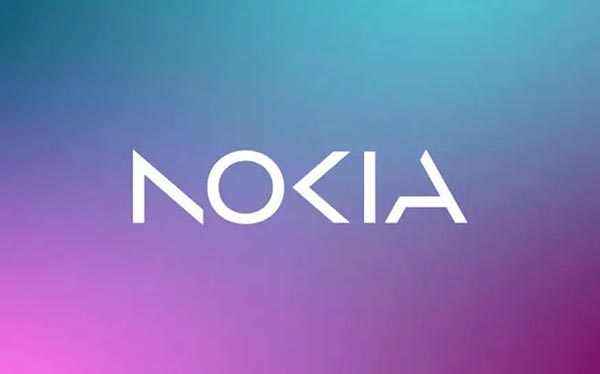
Will their B2B customers understand this? Immediately, probably not. Over time, probably yes. And that’s fine. But will Nokia employees who understand this deeper meaning appreciate the logo more? Inevitably. Especially as it is such a clear break from the past.
Does this pose legibility challenges? Sure. But legibility isn’t the problem. Readability is the issue: do I recognize what it stands for? And for any logotype, readability is a different and far more important measure. And there’s enough context and established recognizability of this brand to ensure readability immediately.
If we were unfamiliar with Nokia we’d probably think that said “Aolia” which, interestingly, is a French telecom company, and not where aioli originated.
More Shift Happens
Last month, we linked to a forthcoming book called Shift Happens, all about the keyboard. The website for the book has all sorts of interactive games and other features you can play around with, and they just launched a new one: a typewriter simulator (note that it only works in Chrome, not Safari).
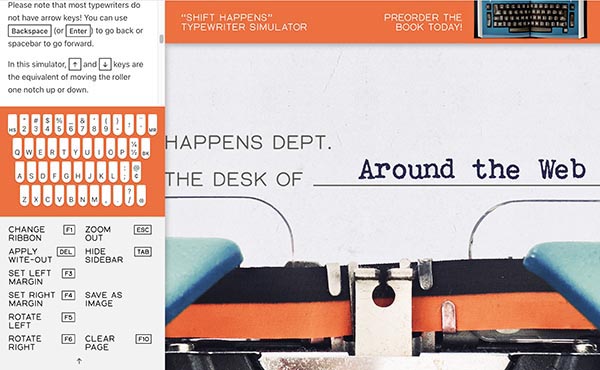
Lots of fun—and you can even change the ribbon. (We presume most people reading this know what that means.)
Key Notes
Speaking of keyboards, Gizmodo has long been a fan of the reMarkable 2, an E Ink device that is not really a full-fledged tablet but rather an “e-note device” that simulates pen-on-paper writing or typing using a touchscreen keypad. They cited that on-screen keyboard as one of the remarkable 2’s weaknesses, which has now been rectified by the availability of an actual, external “Type Folio Keyboard Case.”
The new Type Folio case makes a stronger argument for not letting your reMarkable 2 run around naked, with the addition of a svelte laptop-style keyboard with full-size keys offering 1.3-millimeters of travel. I’ve tried a handful of different keyboard cases for various devices over the past few years, and while many offer a compromised typing experience in an effort to remain thin, the Type Folio does that while also feeling as good to type on as the keys on my MacBook Pro.
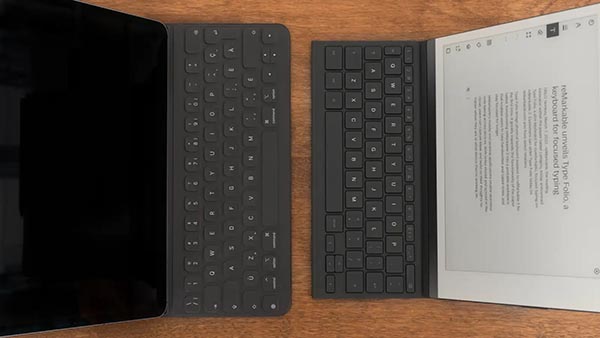
Essentially, it turns the reMarkable 2 into an E Ink typewriter. For those who like to write without the distractions available on a tablet or proper computer, it might be the perfect device.
Bacteria to the Rescue
Much of our modern technology—like LEDs, mobile phones, wind turbines, hard disks, cameras, magnets, low-energy lightbulbs, etc.—is based on rare earth elements (REEs), metals like neodymium and lanthanum. As the name indicates, these metals are, well, rare—they occur at low concentrations (between 0.5 and 67 parts per million) within Earth’s crust. That also makes them expensive (a kilo of neodymium oxide costs about €200, and a kilo of another rare earth, terbium oxide, costs approximately €3,800). Complicating matters, most of the current mining operations are in China, so supply chains are susceptible to disruption, and we know how that goes. However, via PhysOrg, a new study has found that certain kinds of cyanobacteria absorb these elements, the result being that they can be quickly and easily harvested from industrial wastewater and/or recycled electronic waste.
The authors conclude that biosorption of REEs by cyanobacteria is possible even at low concentrations of the metals. The process is also fast: for example, most cerium in solution was biosorbed within five minutes of starting the reaction.
“The cyanobacteria described here can adsorb amounts of REEs corresponding to up to 10% of their dry matter. Biosorption thus presents an economically and ecologically optimized process for the circular recovery and reuse of rare earth metals from diluted industrial wastewater from the mining, electronic, and chemical-catalyst producing sectors,” said Brück.
“This system is expected to become economically feasible in the near future, as the demand and market prices for REEs are likely to rise significantly in the coming years,” he said.
As we become ever-more dependent on our technologies, we are going to need as much cheap and easy access to REEs as possible, so this is good news.
Graphene: Just Eat It
Was it a good week for graphene news? It’s always a good week for graphene news! Two words: edible graphene! Scientists in the UK have developed health sensors using natural elements like rock salt, water, and seaweed—and graphene. From (who else?) Graphene-Info:
The researchers found that their sustainable seaweed-based sensors actually outperform existing synthetic based hydrogels and nanomaterials, used in wearable health monitors, in terms of sensitivity. This also means improvement in accuracy, as the more sensitive a sensor, the more accurately it will record a person’s vital signs.
… The development has the potential to greatly impact health monitoring technology, as future applications of the clinical grade wearable sensors would look something like a second skin or a temporary tattoo: lightweight, easy to apply, and safe, as they are made with all natural ingredients. This would significantly improve the overall patient experience, without the need for more commonly used and potentially invasive hospital instruments, wires and leads.
And then:
Since they are made with ingredients found in nature, the sensors are fully biodegradable, making them more environmentally friendly than commonly used rubber and plastic-based alternatives. Their natural composition also places them within the emerging scientific field of edible electronics – electronic devices that are safe for a person to consume.
This could be useful if, say, health insurance companies start demanding to see data from health monitors. If you get some bad readings, you can just eat the monitor—like spies eating secret messages—and no one is any the wiser!
Edible NDAs
Speaking of eating documents, we at WhatTheyThink sign a lot of NDAs in order to bring you our industry forecasts. But one fundamental flaw of the modern NDA is that you can’t eat them. Well, sure, a paper-based NDA can be eaten like any other paper, but an electronic document? Well, via Boing Boing, now for those who want to be able to consume their trade secrets, San Francisco interactive design studio Hoax has introduced the Edible NDA.

NDA is an edible non-disclosure agreement that protects in perpetuity all information exchanged within 30 minutes of ingestion. Every NDA is comprised of a size 00 gelatin capsule imprinted with a QR code leading to this website and filled with powder made from copies of this agreement printed onto rice paper with ingestible ink. NDA can be executed by any number of people at once. Simply provide every party with their own capsule before executing the agreement. Parties can extend the duration of effect by consuming additional NDA.
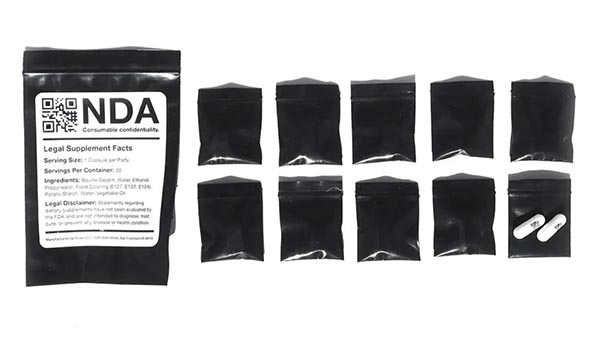
Hoax
Bait and Ouch
Click bait. We all know it, we all know we should avoid it, but many still succumb to temptation.
Oakland, Calif., artist Nemo Gould has created a new piece called “Click Bait,” which is an iPhone combined with a mousetrap. If you press the Facebook “Like” button, whap! You are brutally handed the punishment you so richly deserve.
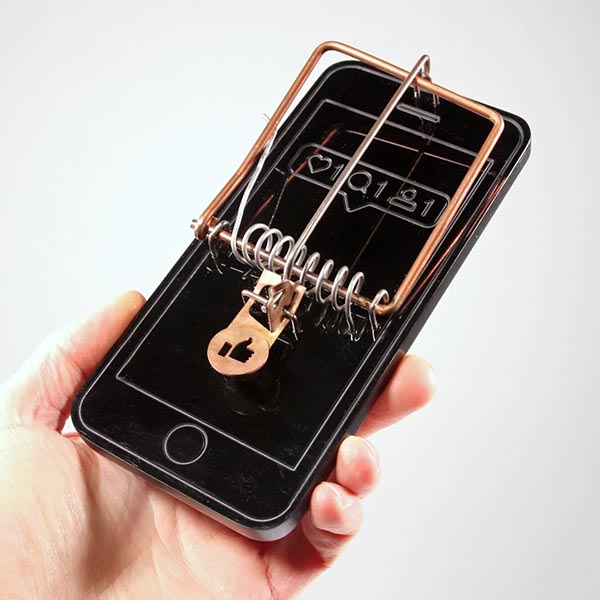
Says Boing Boing:
He made his own spring to reduce its bone-breaking force, but he assures potential purchasers, it still really hurts.
We’ll take his word for it.
STOFU
Not being able to use word spaces can create confusion and requires careful consideration of the unintended interpretation of whatever it is you’re writing. For example, if you were a writers’ group called “Pen Is Mightier” you might want to pay close attention to what your URL would be before you register any domains. Likewise, via Boing Boing, a Maine vegan recently ran into a similar problem when the state DMV confiscated his “obscene” license plate. What did it say? “ILUVTOFU.” Again, a word space would have cleared this up immediately.
Maine, once a lenient state when it came to personalized license plates, recently reversed course and recalled 274 of the states approximately 120,000 plates. One such “obscene” sheet of aluminum belonged to Peter Starostecki, whose family – including children – are vegans, and whose car not only sported the indecent word “tofu” on its plate but was also plastered with tofu bumper stickers (which the state, so far, still permits).
Then again, there are probably some for whom tofu is actually obscene.
Of Thee Icing
Well, doesn’t this take the cake. Made by French artist Alexandre Dubosc, it’s called a “caketrope,” a reference to a zoetrope, or “a device that creates an illusion of motion through a sequence of images.” Check it out:
Next, eat the entire cake, and see what animation takes place when you spin around quickly. We kid, but that is pretty cool.
T. Rents
The producers of Jurassic Park missed a real opportunity… Did you know that you can rent a dinosaur? (It breaks the ice at parties, along with everything else.) Mike and Justin Brabson have founded Atlanta-based Prehistoric Nation that rents out dinosaurs for birthday parties, bar/bat mitzvahs, bachelor/bachelorette parties, and so on. Well, not real dinosaurs, although we’ve been to some parties that could have used a good velociraptor attack. Rather, the two brothers don complex and highly realistic dinosaur costumes and prance about. Via Axios:
In 2021, the brothers quit their day jobs as insurance adjusters and partnered with a friend to buy super-realistic foam-and-fabric costumes and start a live-action dinosaur company.
They discovered the idea while researching potential animal costumes to use for an earlier business idea: a mobile karaoke business that delivered a stage and lights to children’s birthday parties.
… The brothers have amassed a seven-dino army including a Velociraptor named Bleu (no relation to the Velociraptor named “Blue” in “Jurassic World,” definitely not), a Triceratops named Trixie and a 20-foot-long, long-necked Apatosaurus.
Justin often operates the dinosaur while Mike plays the role of dinosaur ranger. It’s an interactive experience more than a science presentation. “We try to have our dinosaurs have a little more emotion and humanize them,” Mike told Axios.
“Humanize” them. If you’re in Georgia this spring, you can watch Prehistoric Nation perform three shows every weekend at Yule Forest’s Tulip Festival in Stockbridge, Ga., from March 18 to April 2.
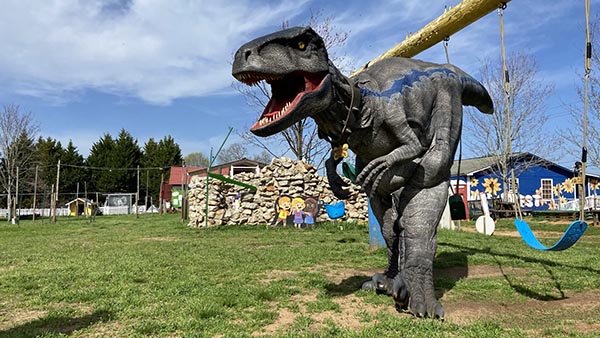
Fett Accompli
Do you like Star Wars? Area rugs? If yes to both, then good news! You’ll definitely want to transform a room into the surface of Tatooine with this Boba Fett escaping the Sarlacc optical illusion rug.
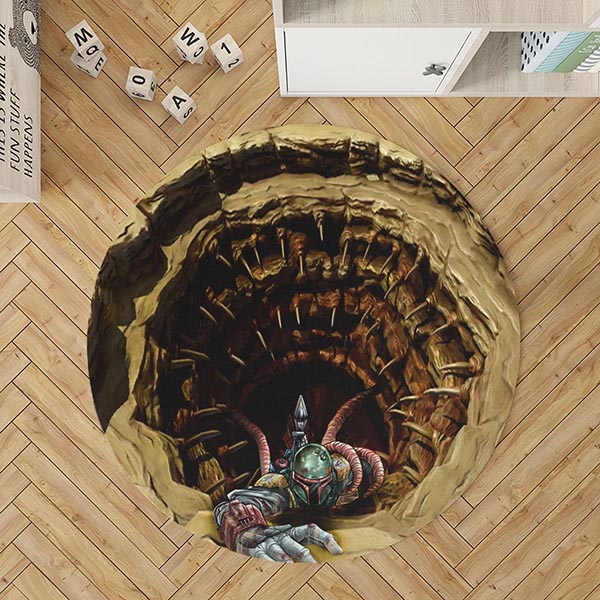
Available in a variety of sizes via online home retailer Swanlion. A small starts at $39.95, and a 2XL will set you back $99.95.
Did anything catch your eye “around the Web” this week? Let us know at [email protected].
This Week in Printing, Publishing, and Media History
March 6
1475: Italian painter and sculptor Michelangelo born.
Michelangelo wrote a poem about how much he disliked painting the Sistine Chapel and his aversion to painting in general. You can read it here: https://t.co/LpiAB5AOIk
— Quite Interesting (@qikipedia) March 7, 2019
1665: The first joint Secretary of the Royal Society, Henry Oldenburg, publishes the first issue of Philosophical Transactions of the Royal Society, the world's longest-running scientific journal.
1885: American journalist and author Ring Lardner born.
1888: American novelist and poet Louisa May Alcott dies (b. 1832).
1899: Bayer registers “Aspirin” as a trademark. What a headache that must have been.
1927: Colombian journalist, author, and Nobel Prize laureate Gabriel García Márquez born (not in the time of cholera).
1943: Norman Rockwell published Freedom from Want in The Saturday Evening Post with a matching essay by Carlos Bulosan as part of the Four Freedoms series.
1946: English singer-songwriter and guitarist David Gilmour born.
1966: English comedian, actor, and screenwriter Alan Davies born.
1975: For the first time the Zapruder film of the assassination of John F. Kennedy is shown in motion to a national TV audience by Robert J. Groden and Dick Gregory.
March 7
1274: Italian priest and philosopher Saint Thomas Aquinas dies (b. 1225).
1765: French inventor of photography Nicéphore Niépce born.
1792: English mathematician, astronomer, experimental photographer, and inventor of the blueprint John Herschel born.
1872: Dutch-American painter Piet Mondrian born.
1876: Alexander Graham Bell is granted a patent for an invention he calls the “telephone.”
1917: American engineer and programmer Frances Elizabeth “Betty” Holberton born. She was one of the six original programmers of ENIAC, the first general-purpose electronic digital computer, and was the inventor of breakpoints in computer debugging.
1999: American director, producer, and screenwriter Stanley Kubrick dies (b. 1928).
March 8
1010: Persian poet Ferdowsi completes his epic poem Shahnameh.
1618: Johannes Kepler discovers the third law of planetary motion.
1775: An anonymous writer, thought by some to be Thomas Paine, publishes “African Slavery in America,” the first article in the American colonies calling for the emancipation of slaves and the abolition of slavery.
1817: The New York Stock Exchange is founded.
1865: American type designer Frederic Goudy born.
1931: American author and critic Neil Postman born. (His 1985 book Amusing Ourselves to Death was eerily prescient.)
1979: Philips demonstrates the compact disc publicly for the first time.
March 9
1454: Italian cartographer and explorer Amerigo Vespucci born.
1776: The Wealth of Nations by Scottish economist and philosopher Adam Smith is published.
1815: Francis Ronalds describes the first battery-operated clock in the Philosophical Magazine.
1842: Giuseppe Verdi’s third opera, Nabucco, receives its première performance in Milan; its success establishes Verdi as one of Italy's foremost opera composers.
1918: American crime novelist Mickey Spillane. (It was Hammer time!)
1954: CBS television broadcasts the See It Now episode, “A Report on Senator Joseph McCarthy,” produced by Fred Friendly.
1959: The Barbie doll makes its debut at the American International Toy Fair in New York.
1963: American journalist and author David Pogue born.
March 10
1876: The first successful test of a telephone is made by Alexander Graham Bell.
1903: American author, playwright, and diplomat, United States Ambassador to Italy Clare Boothe Luce born.
March 11
222: Roman emperor Elagabalus dies (b. 203).
1702: The Daily Courant, England’s first national daily newspaper is published for the first time.
1851: The first performance of Rigoletto by Giuseppe Verdi takes place in Venice.
1952: English author and playwright Douglas Adams born. Don’t panic!
1970: American lawyer and author Erle Stanley Gardner dies (b. 1889).
1989: Sir Tim Berners-Lee submitted his proposal to CERN for an information management system which would be developed into the world wide web.
2020: The World Health Organization (WHO) declares COVID-19 virus a pandemic.
March 12
1838: English chemist and academic William Henry Perkin born. Whilst trying to synthesize artificial quinine to help battle malaria, Perkin accidentally invented the first synthetic organic dye, mauveine, made from aniline.
1858: American newspaper publisher Adolph Ochs born.
1894: Coca-Cola is bottled and sold for the first time in Vicksburg, Mississippi, by local soda fountain operator Joseph A. Biedenharn.
1922: American author and poet Jack Kerouac born.
1928: American director and playwright Edward Albee born.















Discussion
Only verified members can comment.